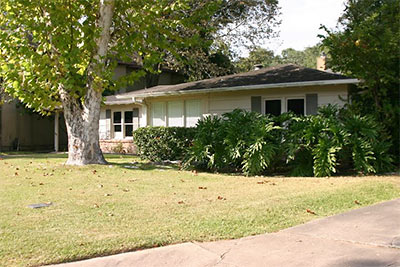
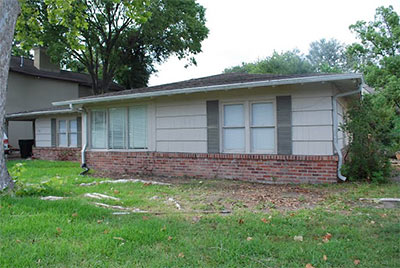
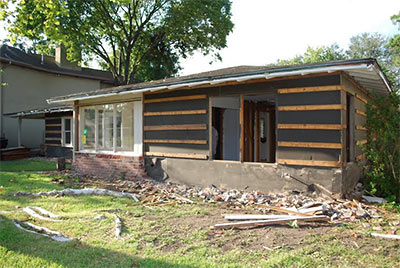
Meanwhile in Ranch Estates, architect Karen Lantz is deconstructing this 1950 Rancher, piece by piece. Her goal: building a new home on the site — but only after finding new homes for most of the materials that are already there.
This type of disassembly is almost unheard of in Houston, where relatively low local landfill tipping fees make crushing and dumping a much cheaper alternative. After 5 local demo companies turned down the work, Lantz decided to contract it all herself. She says she expects to be able to recover and donate 90 percent of the materials in the Banks St. home. Working with an appraiser, she’s been sending materials to the city’s new Reuse Warehouse, Habitat for Humanity of Northwest Harris County, the Houston Habitat Restore, Century Asphalt Materials, and Lone Star Disposal.
“The house going up will absolutely be going for LEED, hopefully the highest rating,” Lantz tells Swamplot. It’s intended for her and her husband. Lantz, the founding president of Houston Mod, says it’s been difficult to convince clients to commit time, energy, or funds toward this sort of attention to materials. Since she’s now preaching the benefits of building deconstruction, she sees this project as an opportunity to practice it.
How much will it cost to strip the place this way?
***
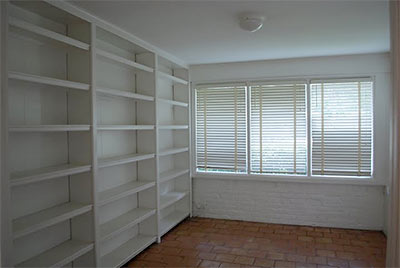
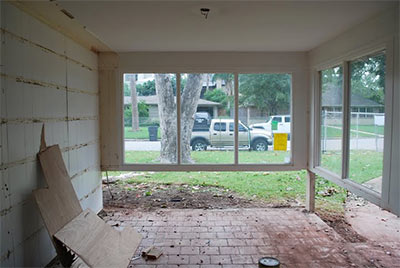
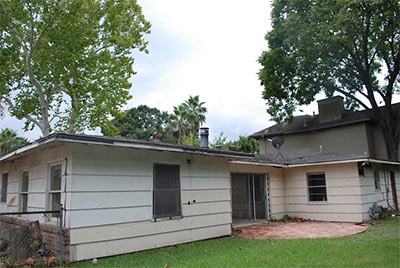
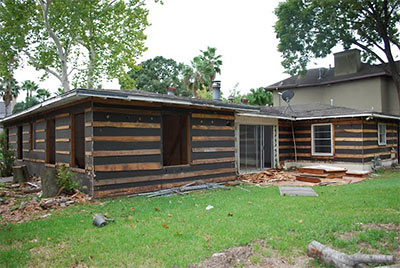
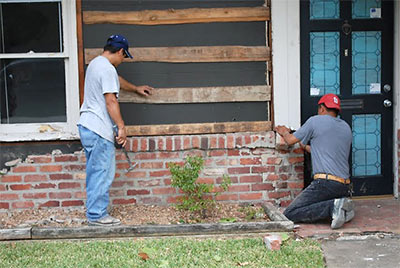
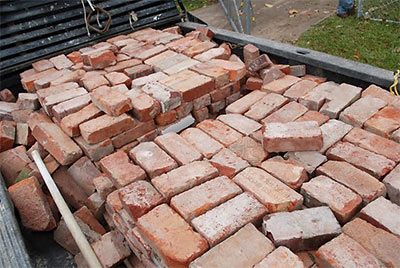
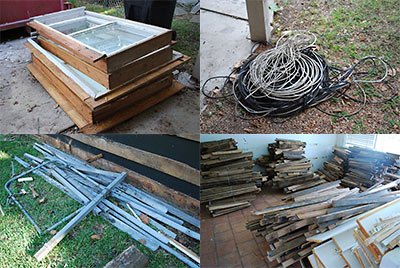
I am working on a cost spreadsheet of deconstruction versus the actual benefit, but I will not have the final totals until I finish. My best guess is that a traditional demolition would cost +/- $6,000 and this method will be +/- $10,000. The charitable donation tax deduction savings benefit will outweigh the total cost. The estimated charitable donation amount from the appraiser is $65,000. The brick is antique and thick solid wood floors are valuable, but we also get value for recycling the wood wall and roof framing, which Habitat for Humanity will use to build new homes. The brick has already been sent to a school that needed it. If the material can be reused, it has a value.
Of the 90% of building material that can be diverted from the landfill, no materials from the house will be sold; they will be donated to non-profit organizations or sent for specialized recycling (see “deconstruction planâ€).
Since I did not find any demolition company to tackle deconstruction of houses in Houston, the costs I will have are not “retail†pricing for consumers. I am not profiting from these efforts.
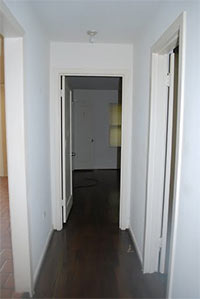
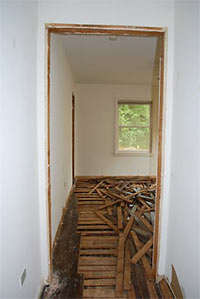
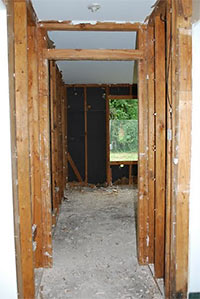
- Up Next: Deconstructing Banks [Lantz Full Circle]
Photos: Karen Lantz



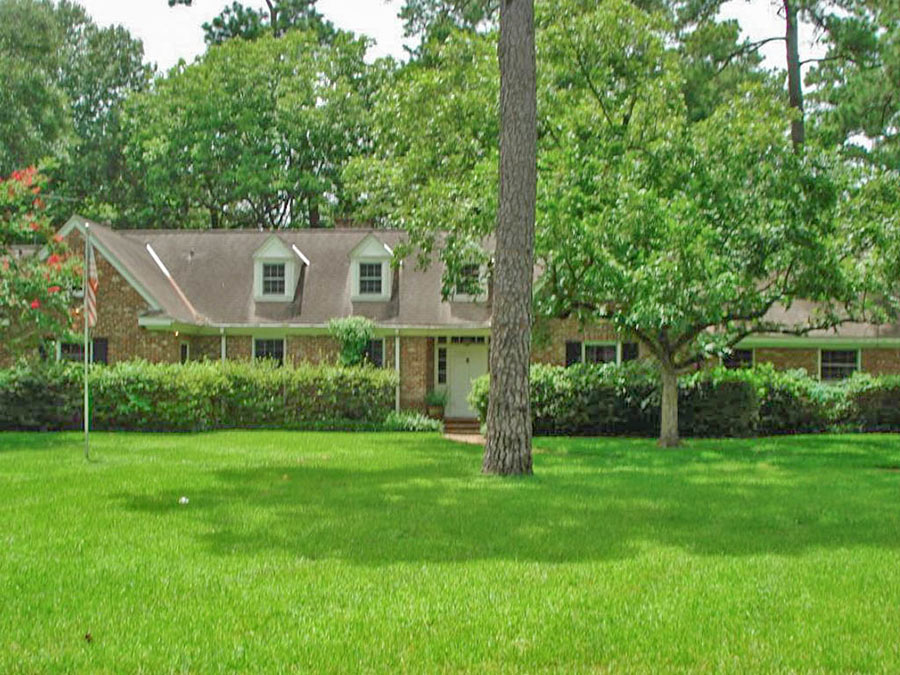

Admirable and well intentioned but logistics and economics are arrayed against it.
It’s admirable work you all are doing! You are the trendsetter and we are looking forward to using some of these materials in our first home project!
The stories these materials weave throughout our lives do not have to be sterile, energy-laden burdens to future generations; but they can be deeply woven into our culture and values. It’s great to think about the stories the materials tell as they are being made into something new. How many Holidays and birthdays were celebrated on those floors? How many storms did the shingles protect them from? Happy memories create happy future spaces!
Keep up the good work!
I say good for you for not letting logistics and/or economics get in the way of such a conscientious and valuable endeavor–sadly, the green movement wouldn’t move very far if everyone were held back by those challenges–good work!
This is great and hopefully this works out in such a manner that more people do it.
One cost left out.
What is the extra time commitment? Or as a developer/builder would ask: How much longer do I have to cover my loan before I can sell?
I know an environmental-specialist architect who won’t accept projects which require demo of existing structures unless the structures or their materials can be incorporated into the project. He’s not interested in adding any more brick, wood, and metal to landfills.
I think this is a truly green project. When it comes to sustainability in architecture, architects typically rely on high-tech solutions (heat recovery, photovoltaics, etc.), but there are also many low-tech ways to be green, like deconstruction. In fact, these low-tech strategies are often more transformative, because they address the very issues that make the accepted social and architectural paradigms/logistics so unsustainable. As reply #2 described, the materials of architecture can be salvaged, born again for new inhabitants, and reinterpreted for contemporary use. It simply makes no sense to build paper buildings and demolish them a couple decades later. This is great example of exciting green design that is also economical. I can’t wait to see the amazing and durable house that Karen designs and constructs here soon after!
Interesting! I hope she does a post-mortem accounting and shares it with us. I am particularly interested in finding out whether the tax savings of donating the old material balance out the extra cost (and the opportunity cost of the extra time).
From this side of the big pond, I say… Good on you Karen! What a great and admirable effort. All the best for the success of the project.
A
This deserves much admiration. Not only does this approach cut down on waste, but those who re-use the materials will be able to reduce the cost of their building/renovation projects.
I’m all for recyclying when it makes economic sense. Is executing the project in this way going to make economic sense? If not wouldn’t the money or time you’re spending on this be better spent on a more efficient way of being “green”? You could donate your extra time and money to a green charity.
This is an interesting exercise. Since labor costs aren’t escalating project costs for a builder who has a succinct time frame and budget, this can be an exercise in just about whatever type of dwelling you wish to construct (or deconstruct, as the case may be).
While I’m not a fanatical greenie, I do many projects myself that are in part, or completely comprised of recycled materials.
I applaud this individual’s pursuit of a passion of her own, by taking on a G.C. role to accomplish her objective. It will be interesting to see final objective time, labor costs, new materials costs, re-used materials savings, financing impact due to elongated site prep, donation related tax deduction savings, etc.
The tax benifit more than out weighs the cost of deconstruction. This is a win-win for the owner or builder of the home, and the organization that the items are donated to. Karen’s project has taken far longer than a typical deconstruction. Karen has been doing this herself and has had to find out and learn of sources and salvage people as she goes along.
I appraise many homes for Habitat for Humanity and Historic Houston, both of these organizations do this type of deconstruction work daily and handle all aspects of the job turnkey. I work with them to value the items and prepare an appraisal and all necessary tax documentation for an IRS compliant income tax deductable donation. I have been working with these organizations for over 8 years and would recomend this approach to most people. Few people have the time and energy of Karen to do this on their own.
Thank you. Unbuilding and traditional demolition require the same amount of time and money to pull permits, disconnect the sewer, water, remove gas and electrical meters, etc. Deconstruction labor accounts for the additional expense of this process and on a positive note, provides jobs. Once the preparation work is complete, a demolition for a simple house would take less than one week with salvage; considering demolition companies reserve the right to make additional profit by reselling brick or wood floors, for example. If for-profit total deconstruction services were offered in Houston with the charitable tax benefit granted to the homeowner, there is no reason that this sustainable process should take more than a few weeks. The added time is modest and yields a tremendous value to the homeowner, community and environment. I will keep you posted. Additional resources linked at http://www.lantzfullcircle.com.
I can see how this works out as a net financial positive for a homeowner who is building a new house on property they own, like Karen (although I would want to see some estimate of opportunity cost included). Can this be made to work for developers? If I want to tear down an old house, build (say) two townhouses on the site, and sell them hopefully at a profit, then time is serious money for me. I’m asking this question of Winston–can this approach (slow deconstruction with donation of reusable materials for the tax break) give a developer a net gain over the fast demolition/landfill method? If so, I’d like to see more developers doing this instead of the usual scrape and dump.
Ummmmmm. Wouldn’t it be a lot greener to leave a perfectly livable home in place and allow a family to enjoy it for another 50 years?
Let’s not kid ourselves. It may be greener than standard demolition, but tearing down usable homes to make way for newer larger homes is not at all green.
The building materials used in the past are of higher quality (durability, density) that many new building products. As we learn to value our resources more saving existing valuable materials will become more popular and frankly, required by all of us.
Thank you for showing us it can be done cost effectively!
Shouldn’t some talented person be able to organize something along the lines of a “reverse” Habitat for Humanity organization, where groups of volunteers deconstruct, rather than construct, homes like this?
The “warm and fuzzy” index for a project like this should be pretty high, and would appeal to the hardcore, motivated volunteer community.
Al’s idea is awesome! Put jobless folks to work too; shades of FDR.
As a builder who has experience using both methods although not to the degree of this project, I can tell you that (when the builder controls the detailed process of deconstruction “By Parts”) there is real money to be made as well as unquantifiable good will from this process. Since the green movement does not pay the bills we are motivated by the green dollar. Having said that. Any builder or developer, who knows his business, knows the value of all materials leaving and arriving a project. As for the speed of this project I cannot and will not comment, but my projects have not run long due to our resources.
It is time to applaud projects that blaze new trails (means and methods) with real impact to both the bottom line and the end product. Those who wait to see if it can be done usally catch the wave too late and miss the opportunity to make a difference and a profit.
It is unrealistic to think that all existing buildings meet todays needs, have been maintained, or address current and future density issues. In order to keep inner cities from into crime infested undersirable areas, it makes more sense to keep the tax base at higher levels which in turn fund social programs for those who need it.
Keep posting your progress. I look foward to seeing the finished project.
great job karen!
Karen,
We had a computer breakdown this morning or I would have commented earlier. We haven’t met yet in person but I am well acquainted with the high quality material you have diverted from the landfill and sent to the Building Materials Reuse Warehouse. The preliminary weight count for this house is 7 tons. It is great to see where the beautiful brick, windows, cedar shake, and other materials came from. Today, Rick Lowe, founder of Project Row Houses and Row House C.D.C. came by the warehouse. He is coming back tomorrow for some of this material. I think he’s going to be able to use many of the windows. It will be interesting to see where they end up. We can’t thank you enough.
Al- Habitat does deconstruct with volunteers as well as build. They maintain a warehouse of used building materials that they sell as well as use to build.
As to RWB’s question..It depends…I wish I could give a better answer than that, but I work with several builders in different areas of town. None of them use this method all the time. It depends on the type and age of the home and their time frame as well. Also, if you have pre-sold the homes and if so , the clients wishes and time table. Most do a combination of deconstruction for a week or two and then level the shell and start building, but as I said It depends on each properties unique situation.
Kudos to the architect, this is an excellent idea. Why not evaluate worth from a moral standard and not just dollar signs? If a person has the means to deconstruct a house to reuse the materials then they should do it. If it ends up being economical, then all the better. What other endeavors do we run cost analyses on? Vacations, raising children, expensive hobbies?
Humans want and seem to need to build things. Respecting the material should be the price we pay, not something we are paid to do.
Slowest demo in town…are you using Andy’s dental tools? I got a sawzall you could use.
We have been watching the progress on your deconstruction and are very impressed with the effort that has been made to keep the site extremely clean and neat. I’m sure that the neighbors on both sides have appreciated your efforts. I hope that though the press being generated by this project, that more developers and builders will look into this method, and I understand that the tax breaks can be substantial.
My last comment regards landfills. This is an extremely important practice which will help our landfills last longer. The less we throw away the slower the landfills fill up and this saves money for the city.
Congratulations on a job well done!
Great Job Karen
Great Job Karen!
Great job cant wait to see the new one finished